GIRL GUIDES CHALLENGE: CANADIAN WOMEN OF VALOUR
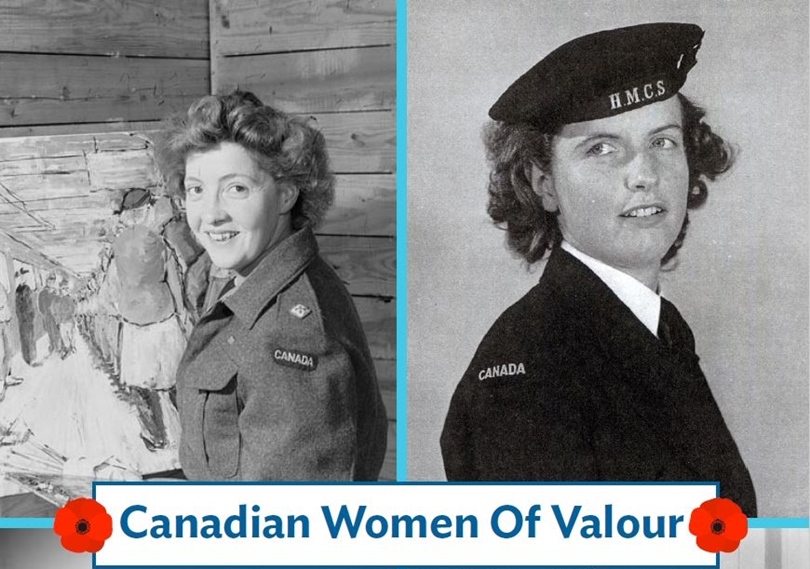



To see this page in PDF format, please click: GGoC – Canadian Women of Valour Program
To see the Alberta Council Girl Guides Program, click HERE
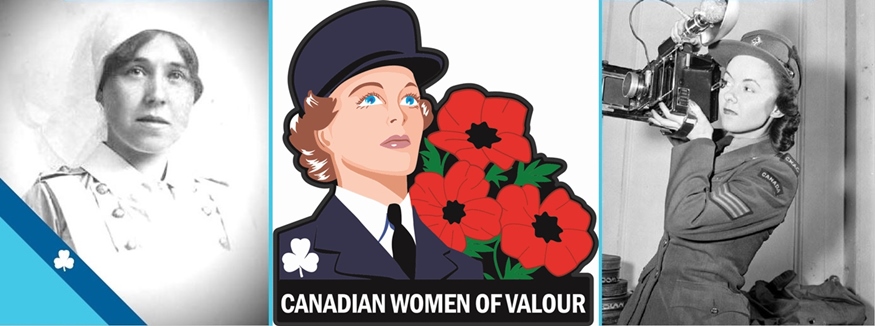
Canadian Women of Valour: Background
Did you know that Girl Guides played important roles in the First and Second World Wars? Through actions big and small, on the front lines (where the fighting was taking place) and at home, Canadian girls and women contributed to the country’s war efforts in many meaningful ways.
This instant meeting is your chance to celebrate Canada’s women of valour – women who showed courage, commitment, bravery and boldness in a dangerous and challenging time. Explore how Canadian girls and women changed their way of life to support their country, and then try out their skills! Hear the stories of women who made a difference and saved lives on the front lines, and find your own way to connect with those who’ve served and continue to serve in Canada’s military.
How will you show you remember?
Choose the activities that work for your unit and find your inspiration! Then, mix and match activities from both themes to create an experience that’s meaningful for you.
Theme 1: Women of valour, at home and at war
Explore some of the realities of life in Canada during the First and Second World Wars, and discover how women supported Canada’s war efforts.
• Ration Recipes
Get creative in the kitchen! Try cooking like Canadians did on the home front during the world wars.
Time needed: 45m – 1 hr
• Wartime Women
Check out the accomplishments of four amazing wartime women. Then, try out their skills!
Time needed: 30m – 45m
• Girl Guides and the War
Did you know Girl Guides in the past supported the war efforts? Give some of what they did a try!
Time needed: 30m – 45m
Theme 2: Lest We Forget
Find your own meaningful way to acknowledge and remember the service of Canadians who fought in wars, veterans who survived a war or Canadians who are serving in the military now.
Head’s up! There are two versions of the Heroes and Sacrifice activity. The first one may be better for Sparks, Brownies and Guides and the one marked (Advanced) may be better for Pathfinders and Rangers. Choose the one that works best for your unit.
• Heroes and Sacrifice
Who’s a hero? What do heroes sacrifice? Draw, think and talk about your ideas in this activity.
Time Needed 15m – 30m
• Heroes and Sacrifice (Advanced)
What does remembrance look like to you? Create a meaningful way to show your remembrance as a unit.
Time Needed 30m – 45m
• Sending Remembrance
During the war, women sent messages of hope and care from home. Now’s your chance to do the same.
Time Needed 30m – 45m
Facilitation Tips for the Canadian Women of Valour Program
• When you talk about war and the military, keep in mind that each person will bring their own lived experiences and knowledge to the conversation. Everyone has different experiences with war, combat, and the military. Some might feel pride and admiration; some may have a family member who was killed, injured, or who experienced trauma connected to war, combat and the military and may hold complex feelings on the subject. Some individuals may have family members who were in opposition to the Canadian military during different combat and peacekeeping missions which can also create questions and complicated feelings.
• As a Guider, you can prepare to support girls in these conversations by engaging in personal reflection before you facilitate this activity.
• Pause and reflect on how your personal identity and lived experience shapes your personal perspective on war and remembrance and how that might influence how you approach this subject in the unit. By doing this kind of reflection in advance, you can support girls in noticing that personal perspectives and behaviour are not always objective or impartial.
• Here are some questions to help encourage your personal reflection: “When I think about wars and the military, what are my immediate thoughts and behaviours?”; “Are my thoughts and behaviours in line with my values?”; “How does my identity and past experience influence the way that I think and behave?”
• You can help girls do the same during these activities by asking curious, thought-provoking, questions like: “What makes you say that?”; “Tell me more about that”; “What experiences are you basing that on?”
• This process may be eye-opening, surprising, and sometimes uncomfortable. Be prepared to encourage and validate all levels of engagement and feelings. There is no right or wrong way to participate or feel in these activities, and remembrance can look different to everyone. You can ensure safe space is protected by letting the unit know that all feelings are valid and will be respected.
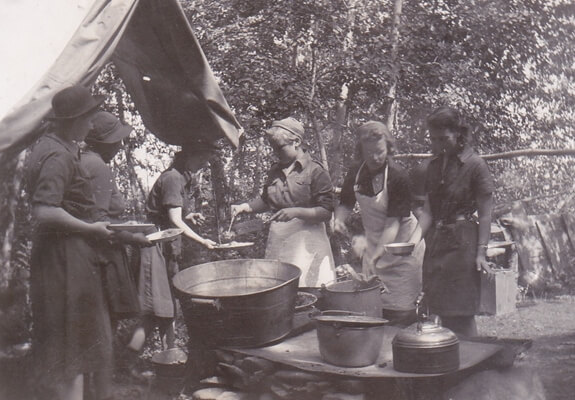
Camp cooking (date and location unknown).
Ration Recipes Activity
Background
How can you make a tasty treat or a delicious meal without its key ingredients? That was a common challenge for Canadians at home during the First and Second World Wars. Try out some wartime recipes to see how they did it!
To make sure Canadian troops had the supplies they needed, especially during the Second World War, many items in Canada, including food, were “rationed”. If something was “rationed” it meant that the Canadian Government limited the amount of it that people could have and buy. For Canadians at home (on the “home front”), common things like sugar, eggs, meat, coffee and even chocolate were limited and hard to get. Changing how they ate was one important way that Canadians supported the country’s war efforts.
For more facts about rationing, check out “Tips, tricks, and more” below.
THEME 1
ACTIVITY 1
What you’ll need:
• Access to an oven/stove
• Ration Recipes Resource (1 copy per group):
Meatless Dinner Vegetable Stew
Jam Tarts Crisp Oat Cookies
• Ingredients – will vary based on the recipes you choose to make (see Ration Recipe Resource for ingredient lists). Check with your unit for food allergies and dietary restrictions before you buy ingredients.
• Kitchen equipment – will vary based on recipes you choose to make
• Oven mitts (1 pair per group) • Serving utensils (1 per recipe)
• Plates (1 per person) • Forks/spoons (1 per person)
• Napkins (1-2 per person) • Optional: Water bottles (1 per person)
What to do:
1. As a unit or in a small group, talk about what rationing is. How might it affect your life today if certain things were rationed? Need a reminder? Check out the explanation of rationing in the “Background” section.
2. Make a small group (if you haven’t already) and gather your supplies and recipe(s).
3. Read over the recipe and share any interesting things you notice about it, like ingredients that are or aren’t included. If you’re not sure what’s typically in the type of recipe you’re working with, you can ask a Guider or Girl Assistant for ideas.
4. Follow the instructions and make your recipe.
5. Come back together as a unit when you’re finished and try a sample of what each of the groups have made.
Did you know?
• During the Second World War, if a person bought more than their share of rationed foods or sold someone more than their share, they could be put in jail or fined. Rationing was serious business!
• To make sure Canadians stayed healthy during food rationing in the Second World War, the Government put together “Canada’s Official Food Rules”. These rules taught people about six “food groups” – milk, cereals and bread, meat, fruits and vegetables, fish and eggs – and how much of each they should eat every day. Sound familiar? You might know it today as Canada’s Food Guide.
• It was so important not to waste food during wartime that even kitchen wastes, like grease and bones, were saved. These could be used in glues and ammunition (like bullets and shells) that were needed on the front lines. Many Canadians grew their own food in “victory gardens” during the Second World Wars so that resources such as gasoline and trucks and trains could be used for transporting items needed for the war rather than for transporting food to Canadians at home.
Credit/Reference: “Food on the Home Front During the Second World War,” Wartime Canada, accessed October 2019, https://wartimecanada.ca/essay/eating/food-home- front-during-second-world-war#footnote10_7xis3my
Facilitation tips:
When it comes to food and eating, it’s important to keep the atmosphere positive, inclusive, accepting, and free of judgements. Check out the Creating a Body- Positive, Food-Positive and Inclusive Environment resource for helpful information about delivering this food-related activity.
Wartime Women Activity
Background
On the home front and on the battlefield, Canadian women played important roles in both world wars. Women filled jobs in factories and on farms, served in various roles the military and made sure families at home were well cared-for. Yet, the stories of women during wartime often go untold!
Here’s your chance to explore some of these stories and the important wartime contributions Canadian women made and continue to make. Then, try your hand at practicing some of their skills!
THEME 1
ACTIVITY 2
What you’ll need:
Wartime Women Stories (at least 1 copy per group)
**Other materials will depend on the story or stories you choose to explore:
Isabel May McDonald (McDonald PDF):
• Blank paper (1-2 sheets per person)
• Pens or pencils (1 per person)
Karen Hermiston (Hermiston PDF):
• Camera or device with camera (1-2 per group)
• Optional: a laptop or another way to view the photos (1 per unit)
Molly Lamb Bobak (Bobak PDF):
• Blank paper; thicker if using paint (1-2 sheets per person)
• Pencils (1 per person)
• Art supplies e.g. paint and brushes or pencil crayons and markers (enough to share)
Nursing Sister Margaret Lowe (Lowe PDF):
• First aid beginners: Make it Stick – Bandage Skills
• Skilled first aiders: Check, Call, Care
What to do:
1. Choose one or more of the Wartime Women Stories to read as a unit or in a small group.
• The Wartime Women Stories are written for an audience at about a Guide’s age and above. If you’re reading the stories out loud to a younger unit, feel free to read only the parts of the stories that are of the most interest and/or appropriate for your unit.
• Share your thoughts with your group about what the woman/women in the stories did during the war they were involved in. What kind of sacrifices did they have to make? What kind of skills and talents did they use during their service?
2. Try your hand at the skills these wartime women used. You could try just one, or try more than one by setting up stations.
• Isabel May McDonald – Create your own secret code. Then, use it to write a message about something important to you. OR Use your creative writing skills to record a memory of someone or an event that’s important to you.
• Karen Hermiston – With your group, snap some photos of things you think are important and should be captured or record for the future. If you have access to a laptop or screen in your meeting space, share your photos with your unit.
• Molly Lamb Bobak – Use art materials to sketch and/or paint images of girls and women that have played an important part in your life.
• Nursing Sister Lowe – Practice some first aid skills using the Make it Stick – Bandage Skills activity for beginners (best for Sparks and Brownies). If you’re more advanced at first aid, you can try the Check, Call, Care activity (best for Guides, Pathfinders and Rangers).
3. Come together as a unit to share your experiences. Why might it be important to explore the contributions of women during wartime?
Facilitation tips:
Want to learn more about the contributions of women during the First and Second World Wars? Check out the “Military History Library” on the Valour Canada website.
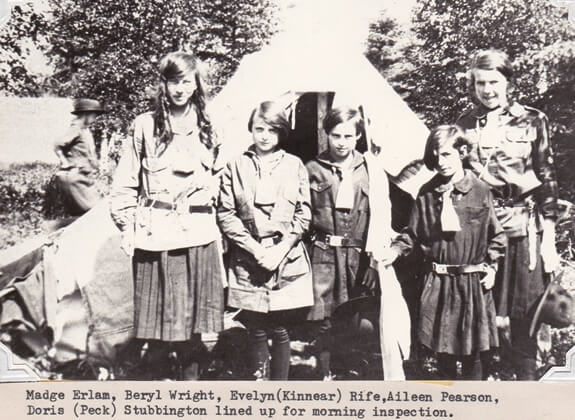
Lining up for inspection (date and location unknown).
Girl Guides and the War Activity
Background
Girl Guides of all ages like to help out. So, it’s no wonder that when wars of the past took place, Girl Guides were quick to step up and help in many ways. To be prepared to help, Girl Guides were trained and tested in all kinds of necessary wartime skills, including:
• Home services – home repairs, first aid and thrifty cooking.
• Child care – looking after children under 10 years old and helping them during an evacuation.
• Transportation – acting as messengers in their community, driving vehicles and orienting using a compass, map, sun and stars.
• Land work – learning about forms of food production.
Are you up to the challenge? This activity will give you a chance to try out the skills Girls in Guiding used during wartime!
Want even more details about what Girl Guides did in the First and Second World Wars? Check out more info in the “Tips, tricks and more” section.
THEME 1
ACTIVITY 3
What you’ll need:
• Bandage rolling (for each group or at the station)
• A roll of gauze • Hand towels (1 or 2)
• Twine or string (6-8 inches) A bowl or basin of water Hand soap
• Childcare relay (for each group or at the station):
• A pitcher with water • A cup
• A doll with removable clothing and an extra set of doll clothing Items you can move around e.g. cones, chairs (4)
• Commemorative Crest Design (for each group):
• Blank paper (1 sheet per person) • Pencils (1 per person)
• Pencil crayons and markers (enough to share)
Before you start:
• Decide if you want to rotate through each of the activities as stations or have more than one group do the same activity at the same time for some friendly competition.
• Set up your supplies:
• Bandage Rolling: Create a hand-washing area at one end of a table with the bowl of water, hand soap, and towel. Place the unrolled gauze roll and twine along the length of the table.
• Childcare Relay: Place pitcher, cup, doll and clothing at the start. Create a line from the start point that covers several metres with the pylons. Try to keep enough space to move easily back and forth between them.
• Crest Design: Set out the supplies.
What to do:
1. Make a small group.
2. Move from station to station as a group, completing the different activities based on things Girl Guides did to support the war.
• Bandage Rolling: Start by washing your hands to keep the bandages clean. Roll the bandage as tight and neatly as possible. Keep it secure by tying a piece of twine around it. Untie the twine and lay out the bandage again at the end of your turn.
• Childcare Relay: One at a time, finish all the childcare tasks before the next person in your group starts their turn.
• Change the clothing on the doll.
• Pour a drink of water for a child. (Pour it back in the pitcher at the end of your turn).
• Hold hands and lead your team back and forth around the pylons to the end of the line and back again to safety. Lead your team in a quick song as a way to lift their spirits.
• Commemorative Crest Design: Design your own version of a crest that Girl Guides may have created during the war to recognize their own efforts to support the war (e.g. a “childcare” badge or a “first aid” badge).
Tips, tricks and more
• During the First Wold War, Guiding members did a lot to support war efforts. They worked in munitions factories, made surgical dressings and bandages, knitted socks for soldiers, assisted in the distribution of leaflets for war relief societies, collected waste paper for Red Cross funds, prepared khaki cloths and made shirts and other articles of soldiers’ clothing in factories.
• With so many resources and so much time directed towards the war efforts, badges couldn’t be made. That didn’t stop Girl Guide members. They made their own embroidering them by hand!
• During the Second World War, Girl Guides organized and ran a two-year National War Service Project called “The Guide Overseas Gift Project”. Beginning in November of 1940, Girl Guide members knit and sewed over 29,665 pieces of clothing. The items they made ranged from booties to overcoats and were sent to England to be handed out to children who had been victims of bombings.
• Want to hear about even more ways that Canadian Guiding units helped out during wartime? Check out our blog: “Opening the vaults: How Girl Guides Contributed to War Efforts”.
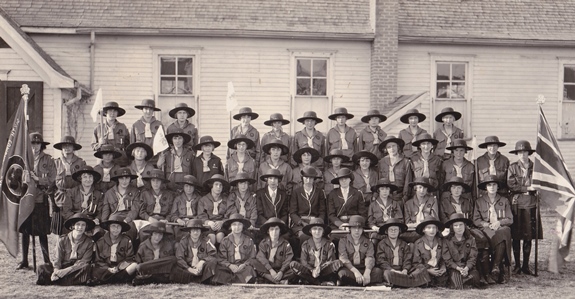
Girl Guides of the 16th Edmonton Groat Ravine Company, 1929.
Heroes and Sacrifices Activity
THEME 2
ACTIVITY 1
For Sparks, Brownies and Guides (Option 1)
Background
When you think of a hero, what comes to mind? Are they make-believe or real? Do they have a super-power or a real-life super skill? Do they sacrifice or give up things to do what they do? In this activity, draw your ideas about what makes someone a “hero” and think about how this might look in real life. Then, share your thoughts about how you can acknowledge or appreciation for what they do.
Head’s up! There are two version of the Heroes and Sacrifice activity. This one may be better for Sparks, Brownies and Guides and the version marked with (Advanced) may be better for Pathfinders and Rangers. Choose the one that works best for your unit.
What you’ll need:
• Blank paper (2 sheets per person)
• Pencils (1 per person)
• Pencil crayons and markers (enough to share)
What to do:
1. Make a small group and invite a Guider and/or Girl Assistant to join you.
2. On your own piece of paper, draw someone you think of when you think of a “hero”. You can draw anyone you want; there’s no right or wrong answer. Share your drawings with your group and talk about who is in your drawing and why you think they’re a hero. With your group, brainstorm what makes someone a hero in real life. You might think about:
• Do they have a certain job? Why do they do what they do?
• What might they be sacrificing (giving up) to do what they do?
3. People who have served in Canadian military, both men and women, have given up lots of things to be able to do what they do.
• What do you think some of those things might be?
• How are people in the military like the heroes you drew on your pages? How are they different?
• Especially in the past, there weren’t many women in the military. What might have been extra hard about being in their shoes?
4. A veteran is someone who has served in a country’s military. Brainstorm some things you can do as a unit to acknowledge and remember the sacrifices veterans have made. This might look different for different people; choose an idea that’s meaningful to your unit and make a plan to follow up on it!
For Pathfinders and Rangers (Option 2)
Background
People have many thoughts, feelings, and experiences when it comes to the military, combat and war. Some are based on a person’s experiences. Others might come from what they’ve learned in school or from a book or a movie. What would showing remembrance for the service of military members look like to you?
In this activity, you’ll work together to come up with a way your unit can acknowledge and show you remember veterans’ service, while also honouring your own feelings and thoughts.
NOTE: There are two versions of the Heroes and Sacrifice activity. This one may be better for Pathfinders and Rangers, while the other may be better for Sparks, Brownies and Guides. Choose the one that works best for your unit.
What you’ll need:
• Chart paper (2 per group and 1 for the unit)
• Markers (1 per person) • A roll of tape (1 total)
What to do:
1. Grab a marker and join a small group. Grab two pieces of chart paper for your group.
2. Sharing one of your pieces of chart paper, silently write down all the ideas you have when thinking about the military, war and sacrifice. You might think about:
• Wars (past and present)
• Members of the military (past and present)
• The roles of women in the military (past and present)
• The military in different countries
• Sacrifices members of the military make
• Why someone might become a member of the military
3. Take a few minutes to read over the ideas on the chart paper to yourself, then talk about them as a group.
4. Sharing your second sheet of chart paper, silently record all the ideas you have for how to acknowledge, respect and remember the service of veterans (those who lived in the past and those who are still living). You might think about:
• What remembrance means to you
• Ways respect and remembrance might look or take place around the world
• How you would like to show remembrance
• How you might recognize the specific contributions of women veterans
5. Take a few minutes to read over the ideas on the chart paper to yourself, then talk about them as a group.
6. Come back together as a unit and use your groups’ chart paper notes to share ideas together.
7. On a new piece of chart paper, do a unit brainstorm: what is one act your unit can take or one thing you can make happen, to acknowledge and remember the service of veterans?
• Talk as a unit to make sure your idea is meaningful to everyone and that it honours your own thoughts and feelings that may have been shared in this activity.
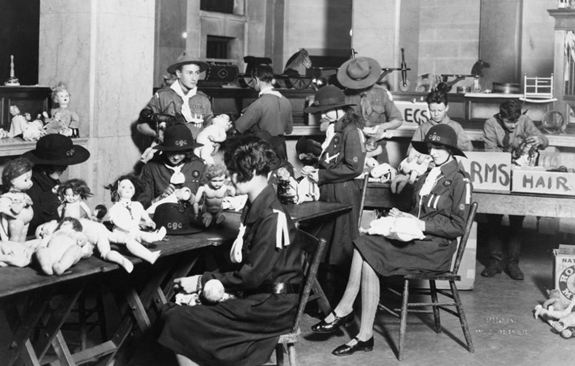
Guides and Scouts working together to make dolls (1930s, but exact date and location unknown).
Sending Remembrance Activity
Background
Many women couldn’t serve in the First and Second World Wars themselves, so they found other ways to help and support the Canadian Forces from home. From sending letters and packages to soldiers, to making small bags for soldiers to carry their personal items in (ditty bags) and rolling needed bandages, there were many ways to show kindness to those in combat.
Why not keep that positivity going! Choose an option below and connect with a past or present member of the Canadian military to send them a positive message and acknowledge their service.
Head’s up! You might want to think about spreading this activity over multiple meetings.
THEME 2
ACTIVITY 2
What you’ll need:
• Materials will vary based on the option you choose.
What to do:
1. With your unit or in a small group, think and share your ideas about why people might want to connect and share kindnesses with those who serve or have served in the military.
• What might happen if you shared your positive messages with them? How might it make them feel?
2. Choose how you’d like to share remembrance or positivity with veterans or current members of the military. You could consider:
• Writing a letter and sending it to a member of the military who’s currently serving. Making valentines as part of the Valentine’s for Vets program.
• Making a care package full of positive messages for a former member of the military.
• Spreading positivity in person by visiting with former members of the military in your local community.
3. Before starting your project, be sure to get all the information you need.
• Check out the links and information in the “Tips, tricks and more” section below.
• If you want to create care packages or connect with former members of the military in your community, you can get in touch with local armories, veterans centres or Legions. You can talk to them about your ideas and find out how to connect with former members of the military. They may also have suggestions about what you could include in a care package, if you’re choosing to send one.
4. Take some time to write your letter or create your valentine’s cards or care packages.
5. Mail your letter or card, or distribute your care package(s) and share your positive messages.
Tips, tricks and more
• For more information on mailing letters to members of the military, check out the section on “Canadians sending letters for ‘Any Canadian Armed Forces Member’ here: https://www.canada.ca/en/department-national-defence/services/contact-us/write-troops/instructions-for-mailing-overseas.html
• For more information on the Valentines for Vets program, check out the information here: https://www.veterans.gc.ca/eng/remembrance/get-involved/valentines-for-veterans
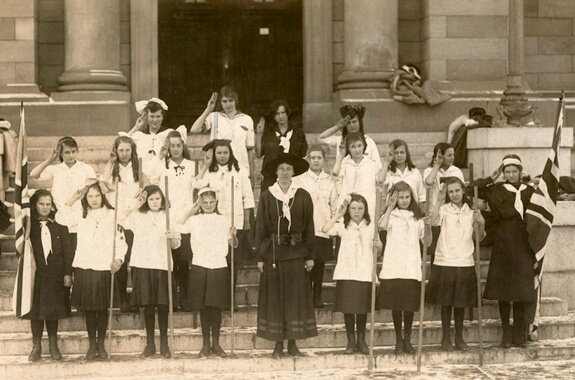
A unit of Girl Guides saluting (Calgary City Hall, 1914).
Other Important Links and Resources
Other Important Links and Resources:
Wartime Guide Badges (historical):
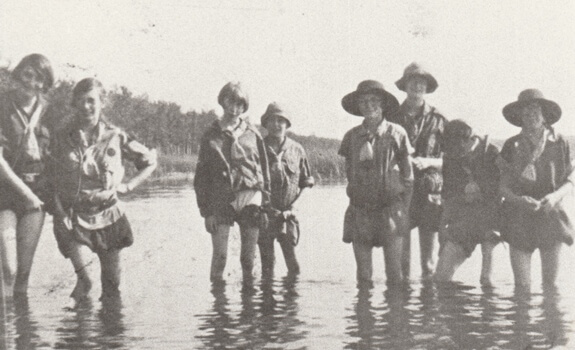 Guides cooling off in the lake (date and location unknown).
Guides cooling off in the lake (date and location unknown).


Credit/Reference: Program modified from Canadian Women of Valour, from Alberta Council, 2019.
Creation of the Canadian Women of Valour Program was a collaborative effort between Girl Guides of Canada and Valour Canada. The expertise of both organizations has been fundamental in ensuring Canadian Women of Valour is a strong and respectful program for members of Girl Guides across Canada.
Please sign up to receive 2-4 emails/year about Valour Canada's educational resources.
You have successfully subscribed to the newsletter
There was an error while trying to send your request. Please try again.